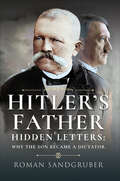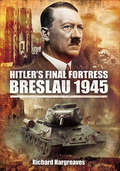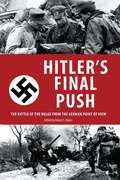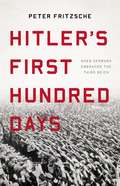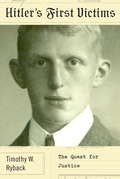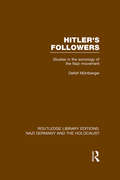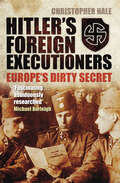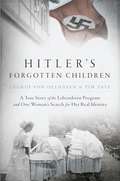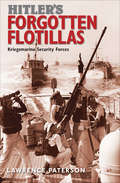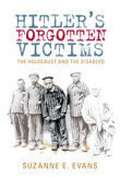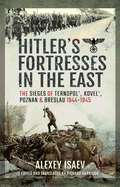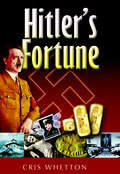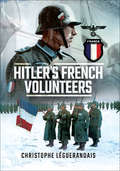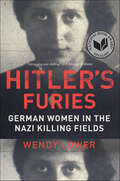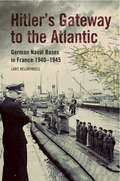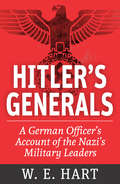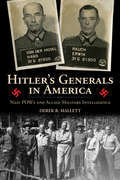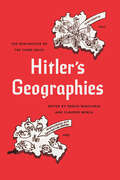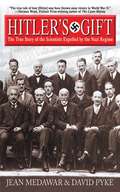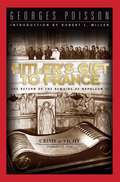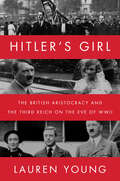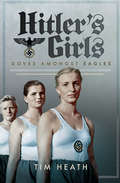- Table View
- List View
Hitler's Father: Hidden Letters: Why the Son Became a Dictator
by Roman SandgruberThe bundle of 31 letters, the pages of which had long yellowed with age, had lain hidden in the attic where they were found for over a century. Only when the razor-sharp script was examined further did historians discover just who had written them – and that person, Alois, was Adolf Hitler’s father. Born Alois Schicklgruber on 7 June 1837, the identity of his biological father still undisclosed, Alois eventually became a civil servant in the Austrian customs service. At around the age of 40, Alois changed his family name from Schicklgruber to Hitler – his infamous son being born some eleven years later. The contents of the re-discovered letters have allowed the renowned historian and author Roman Sandgruber to reassess the image that we have of Alois, offering the world a completely new and authentic impression of the man. In Hitler’s Father, Sandgruber re-examines Alois’ personality and how he significantly shaped the young Adolf. The letters also shed further light onto the everyday life of the Hitler family as whole, a story which is often characterized by myths, inventions and assumptions. They have given the author the opportunity to recount the childhood and youth of the future dictator, painting a dramatic picture of the ‘Führer’ growing up. These letters also help answer the question that is so often asked: How could a child from an Upper Austrian province, seemingly a failure and self-taught, rise to a position of such power? Indeed, Adolf Hitler’s father and ‘the province’ seemingly lay heavily on him until his suicide in the Führerbunker in 1945. The author examines how the young Hitler’s lowly upbringing may have affected him in the years that followed – years which shaped the history of the whole world.
Hitler's Final Fortress: Breslau 1945 (Stackpole Military History Ser.)
by Richard HargreavesA dramatic account of how the Nazis were driven out of Breslau, drawing on the words of those who witnessed it. In January 1945, the Red Army unleashed its long-awaited thrust into Germany with terrible fury. One by one the provinces and great cities of the German East were captured by the Soviet troops. Breslau, capital of Silesia, a city of 600,000 people, stood firm and was declared a fortress by Hitler. A bitter struggle raged as the Red Army encircled Breslau, then tried to pummel it into submission while the city&’s Nazi leadership used brutal methods to keep the scratch German troops fighting and maintain order. Aided by supplies flown in nightly and their building improvised weapons from torpedoes mounted on trolleys to an armored train, the men of Fortress Breslau held out against superior Soviet forces for three months. The price was fearful. By the time Breslau surrendered on May 6, 1945, four days after Berlin had fallen, tens of thousands of soldiers and civilians were dead, the city a wasteland. Breslau was pillaged, its women raped and every German inhabitant driven out of the city which became Wroclaw in postwar Poland. Based on official documents, newspapers, letters, diaries, and personal testimonies, this is the bitter story of Hitler&’s final fortress.
Hitler's Final Push: The Battle of the Bulge from the German Point of View
by Danny S. ParkerNotes on one of the most infamous and bloody battles of World War II--from the German perspective. As the Allied armies swept towards the Reich in late 1944, the German high command embarked on an ambitious plan to gain the initiative on the western front and deal a crippling blow to the Allied war effort. As early as August 1944, when the Germans were being crushed in the east and hammered in Normandy, Hitler was talking of an offensive aimed at destroying as many American and British divisions as possible in a massive surprise assault. By December 1944, Hitler was telling his generals, "the final decisions have been made, everything points to victory. ” This volume consists of primary source material, including translations of German documentation and debriefs of German generals, edited by a foremost expert on this decisive campaign. The Battle of the Bulge presents the assessments by leading figures in the German high command, of the preparations for the offensive, the progress of the operation, and the performance of the Wehrmacht. There are accounts of Generaloberst Alfred Jodl, head of the high command of the armed forces; Schramm, the keeper of the Wehrmacht’s war diary, transcripts of two of Hitler’s key speeches to his generals; and much more. Skyhorse Publishing, as well as our Arcade imprint, are proud to publish a broad range of books for readers interested in history--books about World War II, the Third Reich, Hitler and his henchmen, the JFK assassination, conspiracies, the American Civil War, the American Revolution, gladiators, Vikings, ancient Rome, medieval times, the old West, and much more. While not every title we publish becomes a New York Times bestseller or a national bestseller, we are committed to books on subjects that are sometimes overlooked and to authors whose work might not otherwise find a home.
Hitler's First Hundred Days: When Germans Embraced the Third Reich
by Peter FritzscheThis unsettling and illuminating history reveals how Germany's fractured republic gave way to the Third Reich, from the formation of the Nazi party to the rise of Hitler.Amid the ravages of economic depression, Germans in the early 1930s were pulled to political extremes both left and right. Then, in the spring of 1933, Germany turned itself inside out, from a deeply divided republic into a one-party dictatorship. In Hitler's First Hundred Days, award-winning historian Peter Fritzsche offers a probing account of the pivotal moments when the majority of Germans seemed, all at once, to join the Nazis to construct the Third Reich. Fritzsche examines the events of the period -- the elections and mass arrests, the bonfires and gunfire, the patriotic rallies and anti-Jewish boycotts -- to understand both the terrifying power the National Socialists exerted over ordinary Germans and the powerful appeal of the new era they promised.Hitler's First Hundred Days is the chilling story of the beginning of the end, when one hundred days inaugurated a new thousand-year Reich.
Hitler's First Victims
by Timothy W. RybackThe remarkable story of Josef Hartinger, the German prosecutor who risked everything to bring to justice the first killers of the Holocaust and whose efforts would play a key role in the Nuremberg tribunal. Before Germany was engulfed by Nazi dictatorship, it was a constitutional republic. And just before Dachau Concentration Camp became a site of Nazi genocide, it was a state detention center for political prisoners, subject to police authority and due process. The camp began its irrevocable transformation from one to the other following the execution of four Jewish detainees in the spring of 1933. Timothy W. Ryback's gripping and poignant historical narrative focuses on those first victims of the Holocaust and the investigation that followed, as Hartinger sought to expose these earliest cases of state-condoned atrocity. In documenting the circumstances surrounding these first murders and Hartinger's unrelenting pursuit of the SS perpetrators, Ryback indelibly evokes a society on the brink--one in which civil liberties are sacrificed to national security, in which citizens increasingly turn a blind eye to injustice, in which the bedrock of judicial accountability chillingly dissolves into the martial caprice of the Third Reich. We see Hartinger, holding on to his unassailable sense of justice, doggedly resisting the rising dominance of Nazism. His efforts were only a temporary roadblock to the Nazis, but Ryback makes clear that Hartinger struck a lasting blow for justice. The forensic evidence and testimony gathered by Hartinger provided crucial evidence in the postwar trials. Hitler's First Victims exposes the chaos and fragility of the Nazis' early grip on power and dramatically suggests how different history could have been had other Germans followed Hartinger's example of personal courage in that time of collective human failure.From the Hardcover edition.
Hitler's Followers: Studies in the Sociology of the Nazi Movement (Routledge Library Editions: Nazi Germany and the Holocaust)
by Detlef MuhlbergerWhen originally published in 1991, this book was the first systematic, detailed evaluation of the social structure of the Nazi Party in several regions of Germany during its so-called Kampfzeit phase. Based on extensive archival material, much of it left untouched since the end of the war until Detlef Mühlberger uncovered it, the book demonstrates that the Nazi Party and its major auxiliaries, the SA and the SS mobilized support which was remarkably heterogeneous in social terms. The author reveals that in addition to followers from the middle and upper social classes the Nazi Party enjoyed strong support among the lower class and it was indeed, as it claimed to be a people’s party, or Volkspartei.
Hitler's Foreign Executioners: Europe's Dirty Secret
by Christopher HaleIn Hitler’s Foreign Executioners, Heinrich Himmler’s secret master plan for Europe is revealed: an SS empire that would have no place for either the Nazi Party or Adolf Hitler. His astonishingly ambitious plan depended on the recruitment of tens of thousands of ‘Germanic’ peoples from every corner of Europe, and even parts of Asia, to build an ‘SS Europa’. This revised and fully updated book, researched in archives all over Europe and using first-hand testimony, exposes Europe’s dirty secret: nearly half a million Europeans and more than a million Soviet citizens enlisted in the armed forces of the Third Reich to fight a deadly crusade against a mythic foe, Jewish Bolshevism.Even today, some apologists claim that these foreign SS volunteers were merely soldiers ‘like any other’ and fought a decent war against Stalin’s Red Army. Historian Christopher Hale demonstrates conclusively that these surprisingly common views are mistaken. By taking part in Himmler’s murderous master plan, these foreign executioners hoped to prove that they were worthy of joining his future ‘SS Europa’. But as the Reich collapsed in 1944, Himmler’s monstrous scheme led to bitter confrontations with Hitler – and to the downfall of the man once known as ‘loyal Heinrich’.
Hitler's Forgotten Children
by Tim Tate Ingrid Von OelhafenCreated by Heinrich Himmler, the Lebensborn program abducted as many as half a million children from across Europe. Through a process called Germanization, they were to become the next generation of the Aryan master race in the second phase of the Final Solution. In the summer of 1942, parents across Nazi-occupied Yugoslavia were required to submit their children to medical checks designed to assess racial purity. One such child, Erika Matko, was nine months old when Nazi doctors declared her fit to be a "Child of Hitler." Taken to Germany and placed with politically vetted foster parents, Erika was renamed Ingrid von Oelhafen. Many years later, Ingrid began to uncover the truth of her identity.Though the Nazis destroyed many Lebensborn records, Ingrid unearthed rare documents, including Nuremberg trial testimony about her own abduction. Following the evidence back to her place of birth, Ingrid discovered an even more shocking secret: a woman named Erika Matko, who as an infant had been given to Ingrid's mother as a replacement child. Hitler's Forgotten Children is both a harrowing personal memoir and a devastating investigation into the awful crimes and monstrous scope of the Lebensborn program.INCLUDES PHOTOGRAPHSFrom the Hardcover edition.
Hitler's Forgotten Flotillas: Kriegsmarine Security Forces
by Lawrence Paterson&“A vast amount of information on the German Naval Security Fleet, sicherungsstreitkräfte, producing what is a unique review in depth.&” —Firetrench.com This study of the Kriegsmarine&’s Sicherungsstreitkräfte, their security forces, fills a glaring gap in the study of the German navy in World War II. This wide array of vessels included patrol boats, minesweepers, submarine hunters, barrage breakers, landing craft, minelayers, and even the riverine flotilla that patrolled the Danube as it snaked towards the Black Sea. These vessels may not have provided the glamour associated with capital ships and U-boats, but they were crucial to the survival of the Kriegsmarine at every stage of hostilities. As naval construction was unable to keep pace with the likely demand for security vessels, Grossadmiral Erich Raeder turned to the conversion of merchant vessels. For example, trawlers were requisitioned as patrol boats (Vorpostenboot) and minesweepers (Minensucher), while freighters, designated Sperrbrecher, were filled with buoyant materials and sent to clear minefields. Submarine hunters (U-Boot Jäger) were requisitioned fishing vessels. More than 120 flotillas operated in wildly different conditions, from the Arctic to the Mediterranean, and eighty-one men were to be awarded the Knights Cross; some were still operating after the cessation of hostilities clearing German minefields. The author deals with whole subject at every level, documenting organizational changes, describing the vessels, and recounting individual actions of ships at sea, while extensive appendices round off this major new work. &“Paterson offers a well researched narrative detailing both the large scale aspect of Security Forces operations interspersed with examples of key or typical engagement examples.&” —The International Journal of Maritime History
Hitler's Forgotten Victims: The Holocaust and the Disabled
by Suzanne EvansBetween 1939 and 1945, the Nazi regime systematically murdered hundreds of thousands of children and adults with disabilities as part of its 'euthanasia' policy. These programs were designed to eliminate all persons with disabilities who, according to Nazi ideology, threatened the health and purity of the German race. Hitler's Forgotten Victims explores the development and workings of this nightmarish process, a relatively neglected aspect of the Holocaust. Suzanne Evans's account draws on the rich historical record as well as scores of exclusive interviews with disabled Holocaust survivors. It begins with a description of the Nazis' Children's Killing Program, in which tens of thousands of children with mental and physical disabilities were murdered by their physicians, usually by starvation or lethal injection. The book goes on to recount the T4 euthanasia program, in which adults with disabilities were disposed of in six official centers, and the development of the Sterilization Law that allowed the forced sterilization of at least a half-million young adults with disabilities.
Hitler's Fortresses
by Chris McnabFrom the Siegfried Line to the Atlantic Wall to central Italy, this detailed guide to every level of defensive project in the Third Reich won't disappoint. It takes you inside Channel Islands' pillboxes, Normandy coastal gun positions, and emplaced tank turrets on the Gothic Line in Italy. The secretive world of Hitler's command bunkers is revealed in detail, and the principles and engineering of basic frontline defences are explained, showing how the average German soldier prepared to stand his ground. There is also a dedicated chapter on special-purpose fortifications, including U-boat pens, V-weapon sites, and flak towers.This complete journey into German wartime fortifications reveals much about the strategic and tactical thinking of Hitler and his Wehrmacht, and combat accounts explore how effective the defences were in practice. The book is illustrated throughout with more than 200 drawings, maps, and photographs; the drawings include 3D views and detailed cutaway diagrams, showing exactly how key types of defensive positions looked and functioned. As a guide for both the general historian and for the modern battlefield tourist, Hitler's Fortresses is an authoritative record of the Third Reich's defensive mindset.Hitler's use of manoeuvre warfare should not distract us from his more defensive projects. From the moment Hitler took power in 1933, massive investment went into building fortified defences in Germany's vulnerable regions, particularly along the Franco-German border. The "West Wall", for example, eventually stretched for more than 390 miles and contained some 14,000 pillboxes, being one of the great engineering projects of the 1930s. War expanded Germany's defensive requirements, not least along the Atlantic coastline, where from 1942 to 1944 engineers built a chain of batteries, bunkers, and minefields from Norway to the Franco-Spanish border, which together constituted the "Atlantic Wall". Similarly, chains of defensive works were sunk into the mountainous terrain of Italy between 1943 and 1945, in an attempt to stop the grinding Allied advance.
Hitler's Fortresses in the East: The Sieges of Ternopol', Kovel', Poznan and Breslau, 1944–1945
by Alexey Isaev‘Fortresses must carry out the same tasks as the fortresses of old….They must allow themselves to be surrounded and thus tie down as many enemy forces as possible.’ So Hitler directed in March 1944 and, in so doing, sealed the fate of Ternopol', Kovel', Poznan and Breslau, cities in the Ukraine and Poland that were in the path of the Red Army’s advance towards Nazi Germany. German forces, under orders to resist at all costs, adopted all-round defence and struggled to hold out while waiting for relief – which never came. In this gripping and original book, Alexey Isaev describes, in vivid detail, what happened next –intense and ruthless fighting, horrendous casualties among soldiers and civilians, the fabric of these historic cities torn apart. His account is based on pioneering archival research which offers us an unrivalled insight into the tactics on both sides, the experience of the close-quarter fighting in the streets and houses, and the dreadful aftermath. At the same time he shows why these cities were chosen and how the wider war passed them by as the Wehrmacht retreated and the battlefront moved westward. Each of these cities suffered a similar fate to Stalingrad but their story has never been told before in such graphic and circumstantial detail.
Hitler's Fortune
by Cris WhettonThe true story of how Adolf Hitler amassed billions of dollars in wealth, where that money went—and who may be trying to find it for themselves. In 1918 Adolf Hitler was penniless. But within twenty-five years he was probably the richest man in Europe. In this fascinating book, Cris Whetton reveals not only the extent of Hitler&’s fortune but how it was amassed and those who helped him. As Whetton demonstrates, the royalties from his book, Mein Kampf, were only a small fraction of the total fortune Hitler possessed before World War II began. Whetton delves into the finances of Hitler&’s publishing company Eher Verlag, and his fund Adolf Hitler Spende, to which many people &‘voluntarily&’ contributed, as well as newly uncovered evidence of two of Hitler&’s personal bank accounts. Also explored is how Hitler&’s personal force, magnetism, and attraction to the opposite sex also proved hugely lucrative. Hitler&’s Fortune also follows what happened to the property, the funds, the art collection, and other items after the Fuhrer&’s suicide in 1945, and reveals who is—and who is trying to—profit in modern times from the evil legacy of Adolf Hitler.
Hitler’s French Literary Afterlives, 1945-2017
by Manuel BragançaThis book analyses the successive appearances of Adolf Hitler in French fiction between 1945 and 2017. It discusses why, unlike what has been observed in the US and in the UK, it has proven problematic for French novelists to write about Hitler in their numerous fictional explorations of the Second World War. It examines the literary and ethical challenges of including historical characters such as Hitler in fiction, and demonstrates how these challenges evolved over time as memories of the Second World War also evolved in France.
Hitlers French Volunteers
by Christophe LeguérandaisFrom 1941 to 1945, a large number of foreign soldiers were incorporated into the ranks of the German army in order to compensate for the enormous losses suffered by the Wehrmacht, including thousands of French. Whether fighting against the Soviets on the Eastern Front, with the Afrika-Korps in Tunisia or fighting with the occupying army in France, these volunteers generally took the plunge to join the Germans with the authorization of their own government, even though there was never any 'formal link' to the Vichy regime.For the first time in the English language, this book provides details of the units' various insignias, along with rare and previously unpublished and personal photographs of the few surviving members interviewed by the author. As a result, a new vision of these collaborators emerges, allowing them to be regarded as adventurers or even nationalists. After all, despite being clothed in the enemy's uniform, the majority of these soldiers respected their oath of allegiance, often giving their lives in return.
Hitler's Furies: German Women in the Nazi Killing Fields
by Wendy LowerNATIONAL BOOK AWARD FINALIST. A revelatory history of the role of German women in the Holocaust, not only as plunderers and direct witnesses, but as actual killers on the Eastern Front during World War II.Lower, drawing on twenty years of archival research and fieldwork, presents startling evidence that these women were more than “desk murderers” or comforters of murderous German men: they went on “shopping sprees” and romantic outings to the Jewish ghettos; they were present at killing-field picnics, not only providing refreshment but also shooting Jews. And Lower uncovers the stories of SS wives with children of their own whose brutality is as chilling as any in history.Hitler’s Furies challenges our deepest beliefs: women can be as brutal as men, and the evidence can be hidden for seventy years.“Disquieting . . . Earlier books about the Holocaust have offered up poster girls of brutality and atrocity . . . [Lower’s] insight is to track more mundane lives, and to argue for a vastly wider complicity.” — New York Times“An unsettling but significant contribution to our understanding of how nationalism, and specifically conceptions of loyalty, are normalized, reinforced, and regulated.” — Los Angeles Review of Books“Compelling . . . Lower brings to the forefront an unexplored aspect of the Holocaust.” — Washington Post
Hitler's Gateway to the Atlantic: German Naval Bases in France, 1940–1945
by Lars HellwinkelEmploying new research from both German and French sources, the author examines the role that the French Atlantic ports played for the Kriegsmarine during the Second World War.When the Wehrmacht overran France in May and June of 1940, the German navy's
Hitler's Generals (Essay Index Reprint Ser.)
by W. E. HartHitler's Generals, first published in 1944, is an insider's look at 9 important German military leaders of World War II: 6 in the army, 2 in the navy, and one a head of the air force (Luftwaffe). Included are profiles of: Colonel General Baron Werner von Fritsch, Field Marshal Karl von Rundstedt, Field Marshal Erwin Rommel, Field Marshal Erhard Milch, Field Marshal Walther von Brauchitsch, Field Marshal Wilhelm Keitel, Field Marshal Fedor von Bock, Grand Admiral Karl Doenitz, and Admiral Erich Raeder. Author W. E. Hart had personal knowledge of the men or of their close associates during his time as an officer in the German Army (Reichswehr) before escaping Nazi-controlled Germany and joining the British Army. His critiques of Rommel and von Rundstedt are especially insightful in describing these general's strengths and weaknesses. Included are 8 pages of photographs.
Hitler's Generals in America: Nazi POWs and Allied Military Intelligence
by Derek R. MallettAmericans are familiar with prisoner of war narratives that detail Allied soldiers' treatment at the hands of Germans in World War II: popular books and movies like The Great Escape and Stalag 17 have offered graphic and award-winning depictions of the American POW experience in Nazi camps. Less is known, however, about the Germans captured and held in captivity on U.S. soil during the war.In Hitler's Generals in America, Derek R. Mallett examines the evolution of the relationship between American officials and the Wehrmacht general officers they held as prisoners of war in the United States between 1943 and 1946. During the early years of the war, British officers spied on the German officers in their custody, housing them in elegant estates separate from enlisted soldiers, providing them with servants and cooks, and sometimes becoming their confidants in order to obtain intelligence. The Americans, on the other hand, lacked the class awareness shared by British and German officers. They ignored their German general officer prisoners, refusing them any special treatment.By the end of the war, however, the United States had begun to envision itself as a world power rather than one of several allies providing aid during wartime. Mallett demonstrates how a growing admiration for the German officers' prowess and military traditions, coupled with postwar anxiety about Soviet intentions, drove Washington to collaborate with many Wehrmacht general officers. Drawing on newly available sources, this intriguing book vividly demonstrates how Americans undertook the complex process of reconceptualizing Germans -- even Nazi generals -- as allies against what they perceived as their new enemy, the Soviet Union.
Hitler's Geographies: The Spatialities of the Third Reich
by Claudio Minca Paolo GiaccariaLebensraum: the entitlement of "legitimate" Germans to living space. Entfernung: the expulsion of "undesirables" to create empty space for German resettlement. During his thirteen years leading Germany, Hitler developed and made use of a number of powerful geostrategical concepts such as these in order to justify his imperialist expansion, exploitation, and genocide. As his twisted manifestation of spatial theory grew in Nazi ideology, it created a new and violent relationship between people and space in Germany and beyond. With Hitler's Geographies, editors Paolo Giaccaria and Claudio Minca examine the variety of ways in which spatial theory evolved and was translated into real-world action under the Third Reich. They have gathered an outstanding collection by leading scholars, presenting key concepts and figures as well exploring the undeniable link between biopolitical power and spatial expansion and exclusion.
Hitler’s Germany: Origins, Interpretations, Legacies (2nd edition)
by Roderick StackelbergHitler's Germany provides a comprehensive narrative history of Nazi Germany and sets it in the wider context of nineteenth- and twentieth-century German history. Roderick Stackelberg analyzes how it was possible that a national culture of such creativity and achievement could generate such barbarism and destructiveness. This second edition has been updated throughout to incorporate recent historical research and engage with current debates in the field. It includes: - an expanded introduction focusing on the hazards of writing about Nazi Germany; - an extended analysis of fascism, totalitarianism, imperialism, and ideology; - a broadened contextualization of anti-Semitism; - discussion of the Holocaust including the euthanasia program and the role of eugenics; - new chapters on Nazi social and economic policies and the structure of government as well as on the role of culture, the arts, education, and religion; - additional maps, tables, and a chronology; - a fully updated bibliography. Exploring the controversies surrounding Nazism and its afterlife in historiography and historical memory, Hitler's Germany provides students with an interpretive framework for understanding this extraordinary episode in German and European history.
Hitler's Gift: The True Story of the Scientists Expelled by the Nazi Regime
by David Pyke Jean MedawarBetween 1901 and 1932, Germany won a third of all the Nobel Prizes for science. With Hitler's rise to power and the introduction of racial laws, starting with the exclusion of all Jews from state institutions, Jewish professors were forced to leave their jobs, which closed the door on Germany's fifty-year record of world supremacy in science. Of these more than 1,500 refugees, fifteen went on to win Nobel Prizes, several co-discovered penicillin--and more of them became the driving force behind the atomic bomb project.In this revelatory book, Jean Medawar and David Pyke tell countless gripping individual stories of emigration, rescue, and escape, including those of Albert Einstein, Fritz Haber, Leo Szilard, and many others. Much of this material was collected through interviews with more than twenty of the surviving refugee scholars, so as to document for history the steps taken after Hitler's policy was enacted. As one refugee scholar wrote, "Far from destroying the spirit of German scholarship, the Nazis had spread it all over the world. Only Germany was to be the loser."Hitler's Gift is the story of the men who were forced from their homeland and went on to revolutionize many of the scientific practices that we rely on today. Experience firsthand the stories of these geniuses, and learn not only how their deportation affected them, but how it bettered the world that we live in today.
Hitler's Gift to France
by Georges Poisson Robert MillerIn the dead of the winter of 1940, Hitler decided to return from its burial place in Vienna the ashes of Napoleon II, known as the "Aiglon," the only son of the emperor Napoleon. The gesture was intended to win the support of the French people, but only managed to precipitate a political crisis at Vichy, where Marshal Pétain ordered the pro-German Deputy Prime Minister Pierre Laval arrested. Based on new research and previously unknown documents, the author, historian Georges Poisson, at last sheds light on an incident most historians--including Robert O. Paxton--have been at a loss to explain.
Hitler's Girl: The British Aristocracy and the Third Reich on the Eve of WWII
by Lauren YoungA timely, riveting book that presents for the first time an alternative history of 1930s Britain, revealing how prominent fascist sympathizers nearly succeeded in overturning British democracy—using the past as a road map to navigate the complexities of today’s turn toward authoritarianism.Hitler’s Girl is a groundbreaking history that reveals how, in the 1930s, authoritarianism nearly took hold in Great Britain as it did in Italy and Germany. Drawing on recently declassified intelligence files, Lauren Young details the pervasiveness of Nazi sympathies among the British aristocracy, as significant factions of the upper class methodically pursued an actively pro-German agenda. She reveals how these aristocrats formed a murky Fifth Column to Nazi Germany, which depended on the complacence and complicity of the English to topple its proud and long-standing democratic tradition—and very nearly succeeded.As she highlights the parallels to our similarly treacherous time, Young exposes the involvement of secret organizations like the Right Club, which counted the Duke of Wellington among its influential members; the Cliveden Set, which ran a shadow foreign policy in support of Hitler; and the shocking four-year affair between socialite Unity Mitford and Adolf Hitler.Eye-opening and instructive, Hitler’s Girl re-evaluates 1930s England to help us understand our own vulnerabilities and poses urgent questions we must face to protect our freedom. At what point does complacency become complicity, posing real risk to the democratic norms that we take for granted? Will democracy again succeed—and will it require a similarly cataclysmic event like World War II to ensure its survival? Will we, in our own defining moment, stand up for democratic values—or will we succumb to political extremism?
Hitler's Girls: Doves Amongst Eagles
by Tim HeathThe &“frank, tragic, bittersweet, brutal, emotional&” true story of the Third Reich&’s so-called she-devils of the League of German Girls (Gerry Van Tonder, author of Berlin Blockade). They were ten to eighteen years old: German girls who volunteered for the war effort, and were indoctrinated into the Nazi youth organizations, Jungmädelbund and Bund Deutcscher Mädel. At first they were schooled in a very narrow education: how to cook, clean, excel at sports, birth babies, and raise them. But when Hitler called, they were trained, militarized, and exploited for the ultimate goal of the Third Reich. From the prosperous beginnings of the League of German Girls in 1933 to the cataclysmic defeat of 1945, Hitler&’s Girls is an insightful, disturbing, and revealing exploration of their specific roles: what was expected of them, and how they delivered, as defined by the Nazi state. Were they unwitting pawns or willing accessories to genocide? Historian Tim Heath searches for the answers and provides a definitive voice for this unique, and until now, unheard generation of German females. &“An essential account of the women who served Hitler during his years of power. Stunning photographs but a chilling narrative, in view of what they were required to do.&” —Books Monthly
